同济大学:《水资源管理》课程教学资源(教案讲义)03 Energy-water nexus in urban water systems
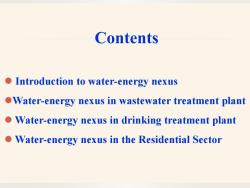
Contents oIntroduction to water-energy nexus Water-energy nexus in wastewater treatment plant Water-energy nexus in drinking treatment plant ●】 Water-energy nexus in the Residential Sector
Contents ⚫ Introduction to water-energy nexus ⚫Water-energy nexus in wastewater treatment plant ⚫ Water-energy nexus in drinking treatment plant ⚫ Water-energy nexus in the Residential Sector
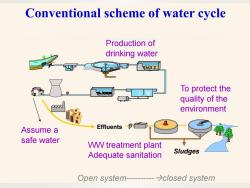
Conventional scheme of water cycle Production of drinking water To protect the quality of the environment Assume a Effluents8与 safe water W treatment plant Adequate sanitation Sludges Open system---------->closed system
Conventional scheme of water cycle Sludges Effluents WW treatment plant Adequate sanitation Production of drinking water To protect the quality of the environment Assume a safe water Open system----------→closed system
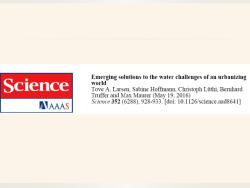
Emerging solutions to the water challenges of an urbanizing Science world Tove A.Larsen,Sabine Hoffmann,Christoph Luithi,Bernhard Truffer and Max Maurer (May 19,2016) ATAAAS Science352(6288),928-933.[doi:10.1126/science.aad8641]
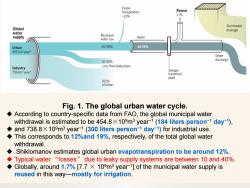
Evapo- transpiration Reuse -129% 17% Stormwater Global drainage water supply Municipal Sewer water use Urban 60-90% 4878% 455 km year Sewer 10-40% discharge Industry Loss from leaky pipes Sewage 739 km year treatment plant 162% of urban Fig.1.The global urban water cycle. According to country-specific data from FAO,the global municipal water withdrawal is estimated to be 454.8x 109m3 year-1(184 liters person-1 day-1), and 738.8X 109m3 year-1(300 liters person-1 day-1)for industrial use. This corresponds to 12%and 19%,respectively,of the total global water withdrawal. Shiklomanov estimates global urban evapotranspiration to be around 12%. Typical water "losses"due to leaky supply systems are between 10 and 40%. Globally,around 1.7%[7.7 X 109m3 year-1]of the municipal water supply is reused in this way-mostly for irrigation
Fig. 1. The global urban water cycle. ◆ According to country-specific data from FAO, the global municipal water withdrawal is estimated to be 454.8×109m3 year−1 (184 liters person−1 day−1), ◆ and 738.8×109m3 year−1 (300 liters person−1 day−1) for industrial use. ◆ This corresponds to 12%and 19%, respectively, of the total global water withdrawal. ◆ Shiklomanov estimates global urban evapotranspiration to be around 12%. ◆ Typical water “losses” due to leaky supply systems are between 10 and 40%. ◆ Globally, around 1.7% [7.7 × 109m3 year−1] of the municipal water supply is reused in this way—mostly for irrigation
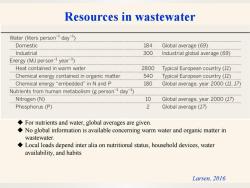
Resources in wastewater Water (liters person1 day) Domestic 184 Global average(69) Industrial 300 Energy (M)personyear) Industrial global average(69) Heat contained in warm water 2800 Typical European country(11) Chemical energy contained in organic matter 540 Typical European country (11) Chemical energy"embedded"in N and P 180 Global average,year 2000(11,17) Nutrinfrom human metabolism personday1 Nitrogen(N) 10 Global average.year 2000(17) Phosphorus (P) 2 Global average(17) For nutrients and water,global averages are given. No global information is available concerning warm water and organic matter in wastewater. Local loads depend inter alia on nutritional status,household devices,water availability,and habits Larsen,2016
Larsen, 2016 Resources in wastewater ◆ For nutrients and water, global averages are given. ◆ No global information is available concerning warm water and organic matter in wastewater. ◆ Local loads depend inter alia on nutritional status, household devices, water availability, and habits
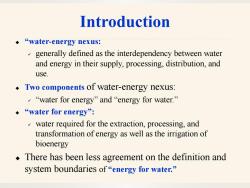
Introduction ◆“water-energy nexus: generally defined as the interdependency between water and energy in their supply,processing,distribution,and use. Two components of water-energy nexus: “water for energy'and“energy for water.” ◆“water for energy”: water required for the extraction,processing,and transformation of energy as well as the irrigation of bioenergy There has been less agreement on the definition and system boundaries of“energy for water
Introduction ◆ “water-energy nexus: ✓ generally defined as the interdependency between water and energy in their supply, processing, distribution, and use. ◆ Two components of water-energy nexus: ✓ “water for energy” and “energy for water.” ◆ “water for energy”: ✓ water required for the extraction, processing, and transformation of energy as well as the irrigation of bioenergy ◆ There has been less agreement on the definition and system boundaries of “energy for water
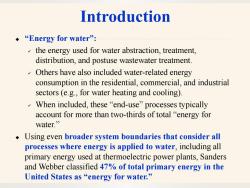
Introduction ◆“Energy for water'": the energy used for water abstraction,treatment, distribution,and postuse wastewater treatment. Others have also included water-related energy consumption in the residential,commercial,and industrial sectors (e.g.,for water heating and cooling). When included,these"end-use"processes typically account for more than two-thirds of total "energy for water." Using even broader system boundaries that consider all processes where energy is applied to water,including all primary energy used at thermoelectric power plants,Sanders and Webber classified 47%of total primary energy in the United States as“energy for water
Introduction ◆ “Energy for water”: ✓ the energy used for water abstraction, treatment, distribution, and postuse wastewater treatment. ✓ Others have also included water-related energy consumption in the residential, commercial, and industrial sectors (e.g., for water heating and cooling). ✓ When included, these “end-use” processes typically account for more than two-thirds of total “energy for water.” ◆ Using even broader system boundaries that consider all processes where energy is applied to water, including all primary energy used at thermoelectric power plants, Sanders and Webber classified 47% of total primary energy in the United States as “energy for water
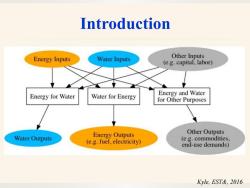
Introduction Energy Inputs Water Inputs Other Inputs (e.g.capital,labor) Energy for Water Water for Energy Energy and Water for Other Purposes Other Outputs Water Outputs Energy Outputs (e.g.fuel,electricity) (e.g.commodities, end-use demands) Kyle,EST&,2016
Kyle, EST&, 2016 Introduction
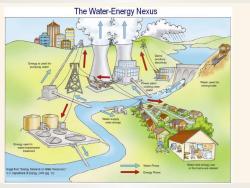
The Water-Energy Nexus Energy is used for pumping water Water used for mining fuels Water supply uses energy Enorgy used in water/wastewater treatment 0 Water Flows Water and energy use mage from"Energy Demands on Water Resources," in the home are related U.S.Department of Energy,2006(pg.13) Energy Flows
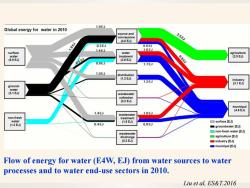
1.9EJ Global energy for water in 2010 source and conveyance 2.5EJ (4.0EJ) 0.3EJ 0.6E 1.4EJ 1.0EJ water 05E 0.9Ej 0.9EJ 1.7EJ 1.0EJ distribution (1.2EJ) 1.2EJ industry (3.1EJ ground- water (3.1EJ wastewater collection (0.2EJ 1.4EJ wastewater 1.0E』 non-fresh treatment water (1.8EJ) □surface [EJ] (1.2EJ 0.4EJ 0.9EJ ■groundwater[EJ wastewater □non-fresh water [EJ] disc ge agriculture [EJ] 0.2E0 ☐industry [EJ] ■municipal[EJ Flow of energy for water(E4W,EJ)from water sources to water processes and to water end-use sectors in 2010. Liu et al,ES&T.2016
Flow of energy for water (E4W, EJ) from water sources to water processes and to water end-use sectors in 2010. Liu et al, ES&T.2016
按次数下载不扣除下载券;
注册用户24小时内重复下载只扣除一次;
顺序:VIP每日次数-->可用次数-->下载券;
- 同济大学:《水资源管理》课程教学资源(教案讲义)02 Water Resources Management Tool - Water Footprint(WF).pdf
- 同济大学:《水资源管理》课程教学资源(教案讲义)01 Introduction to water resources(负责人:王洪涛).pdf
- 同济大学:《给水工程原理与技术》课程电子教案(课件讲稿)Mixing Coagulation - Flocculation.pdf
- 同济大学:《给水工程原理与技术》课程电子教案(课件讲稿)Advanced Oxidation.pdf
- 同济大学:《给水工程原理与技术》课程电子教案(课件讲稿)Municipal Water Purification Plant.pdf
- 同济大学:《给水工程原理与技术》课程电子教案(课件讲稿)Membrane technology.pdf
- 同济大学:《给水工程原理与技术》课程电子教案(课件讲稿)Filtration.pdf
- 同济大学:《给水工程原理与技术》课程电子教案(课件讲稿)Sedimentation.pdf
- 同济大学:《固体废物处理与资源化》课程教学资源(讲稿)Leachate and Landfill Gas.pdf
- 同济大学:《固体废物处理与资源化》课程教学资源(讲稿)Incineration, pyrolysis & gasification.pdf
- 同济大学:《固体废物处理与资源化》课程教学资源(讲稿)Biogas – a way to solve sanitation problems.pdf
- 同济大学:《固体废物处理与资源化》课程教学资源(讲稿)Waste processing technologies application.pdf
- 同济大学:《固体废物处理与资源化》课程教学资源(讲稿)Introduction on Solid Waste.pdf
- 《固体废物处理与资源化》课程教学资源(文献资料)LANDFILL MANUALS LANDFILL SITE DESIGN.pdf
- 《固体废物处理与资源化》课程教学资源(文献资料)The anaerobic digestion process of biogas production from food waste - Prospects and constraints.pdf
- 《固体废物处理与资源化》课程教学资源(文献资料)Efficient reduction of antibiotic residues and associated resistance genes in tylosin antibiotic fermentation waste using hyperthermophilic composting.pdf
- 《固体废物处理与资源化》课程教学资源(文献资料)A feasibility assessment of an integrated plastic waste system adopting.pdf
- 长沙理工大学:《环境监测》课程教学资源(课件讲稿,打印版)第9章 环境监测质量保证.pdf
- 长沙理工大学:《环境监测》课程教学资源(课件讲稿,打印版)第5章 土壤质量监测 Soil Pollution Monitoring.pdf
- 长沙理工大学:《环境监测》课程教学资源(课件讲稿,打印版)第3章 大气和废气监测 Atmosphere and flue waste gas monitoring.pdf
- 同济大学:《水资源管理》课程教学资源(教案讲义)04 Water Quality Modeling、Reactions & Transport、Dissolved Oxygen Modeling in Rivers、Eutrophication.pdf
- 同济大学:《水资源管理》课程教学资源(教案讲义)05 Trans-boundary water resources management.pdf
- 同济大学:《水资源管理》课程教学资源(教案讲义)06 Water Resource Management - Sponge City.pdf
- 同济大学:《水资源管理》课程教学资源(教案讲义)08 Case in Lake Victoria, East Africa.pdf
- 同济大学:《水资源管理》课程教学资源(教案讲义)07 Brief Introduction to Integrated Water Environment Rehabilitation、A Big Picture:China City’s Effort to Improve River Water Quality with Shanghai as a Case、River water quality assessment and water pollution sources survey.pdf
- 上海海洋大学:海洋生态与环境学院课程教学大纲汇编(2018版).pdf
- 兰州交通大学:《环境保护与可持续发展》课程教学资源(大纲讲义)教学大纲 Environmental protection and sustainable development.pdf
- 兰州交通大学:《环境保护与可持续发展》课程教学资源(试卷习题)试卷1.doc
- 兰州交通大学:《环境保护与可持续发展》课程教学资源(试卷习题)试卷2.doc
- 兰州交通大学:《环境保护与可持续发展》课程教学资源(试卷习题)试卷3.doc
- 兰州交通大学:《环境保护与可持续发展》课程教学资源(试卷习题)试卷4.doc
- 兰州交通大学:《环境保护与可持续发展》课程教学资源(试卷习题)试卷5.doc
- 兰州交通大学:《环境保护与可持续发展》课程教学资源(授课教案)第一章 地球环境的基本特征.doc
- 兰州交通大学:《环境保护与可持续发展》课程教学资源(授课教案)第二章 生态系统.doc
- 兰州交通大学:《环境保护与可持续发展》课程教学资源(授课教案)第三章 人口与资源.doc
- 兰州交通大学:《环境保护与可持续发展》课程教学资源(授课教案)第四章 资源短缺.doc
- 兰州交通大学:《环境保护与可持续发展》课程教学资源(授课教案)第五章 环境污染 Environmental Pollution.doc
- 兰州交通大学:《环境保护与可持续发展》课程教学资源(授课教案)第六章 生态破坏 Ecology Damage.doc
- 兰州交通大学:《环境保护与可持续发展》课程教学资源(授课教案)第七章 全球环境问题.doc
- 兰州交通大学:《环境保护与可持续发展》课程教学资源(授课教案)第八章 可持续发展的基本理论.doc
